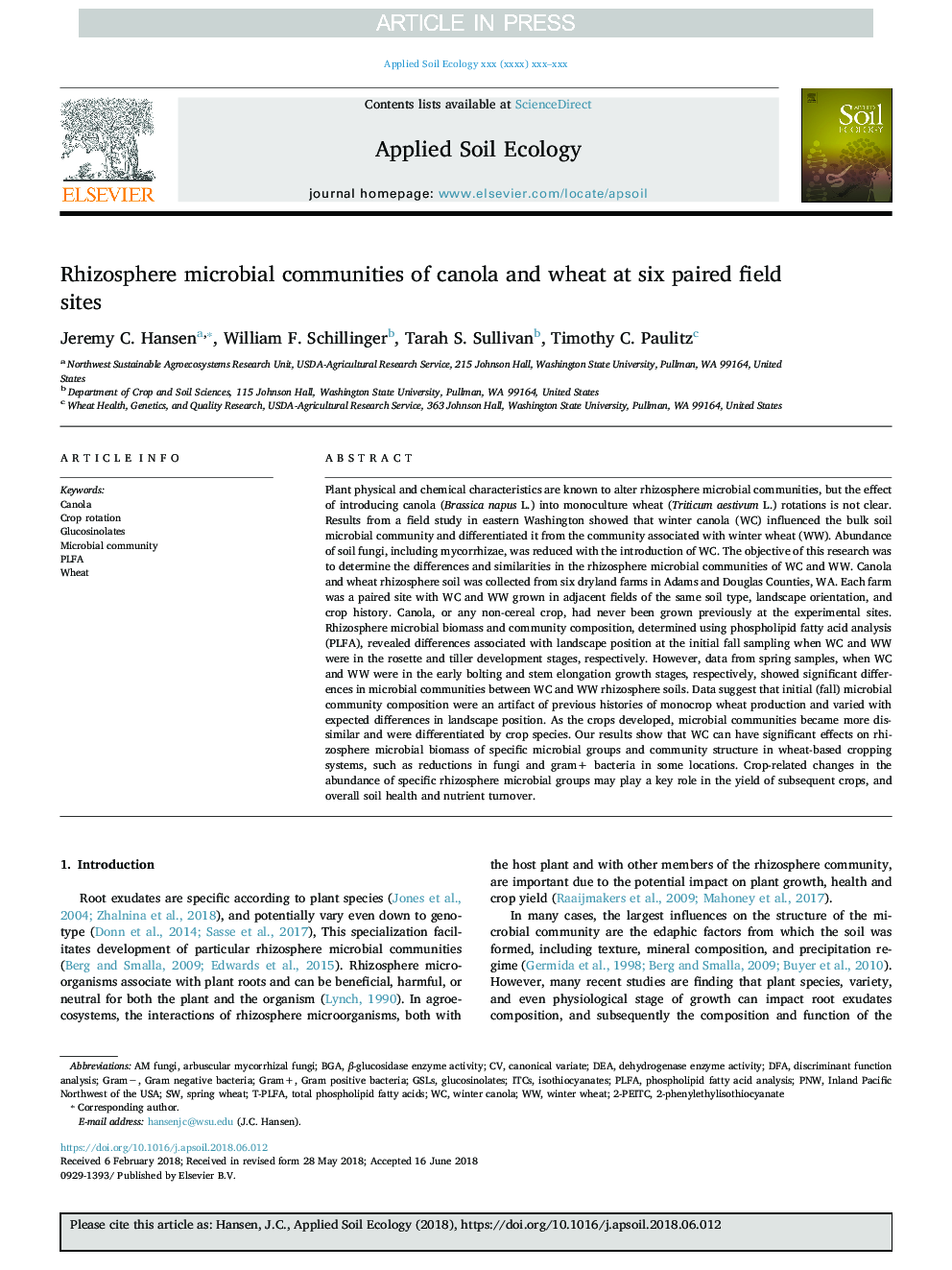| کد مقاله | کد نشریه | سال انتشار | مقاله انگلیسی | نسخه تمام متن |
|---|---|---|---|---|
| 8846587 | 1617753 | 2018 | 9 صفحه PDF | دانلود رایگان |
عنوان انگلیسی مقاله ISI
Rhizosphere microbial communities of canola and wheat at six paired field sites
ترجمه فارسی عنوان
جوامع میکروبی ریزوسفر از کلزا و گندم در شش مکان زرد
دانلود مقاله + سفارش ترجمه
دانلود مقاله ISI انگلیسی
رایگان برای ایرانیان
کلمات کلیدی
DEAPNWGram+Dehydrogenase enzyme activityGSLSITCsBGADFAPLFAIsothiocyanates - ایزوتوسیانات هاGram positive bacteria - باکتری های گرم مثبتGram negative bacteria - باکتری های گرم منفیPhospholipid fatty acid analysis - تجزیه اسید چرب فسفولیپیدDiscriminant function analysis - تجزیه و تحلیل عملکردCrop rotation - توالی کاشت، کشت تناوبی، تناوب کشت، تناوب زراعیMicrobial community - جامعه میکروبیAM fungi - قارچ AMArbuscular mycorrhizal fungi - قارچ های میکوریزا آربوسکولارCanola - کانولاGlucosinolates - گلوکوزینولاتWheat - گندمSpring wheat - گندم بهارWinter wheat - گندم زمستانه
موضوعات مرتبط
علوم زیستی و بیوفناوری
علوم کشاورزی و بیولوژیک
بوم شناسی، تکامل، رفتار و سامانه شناسی
چکیده انگلیسی
Plant physical and chemical characteristics are known to alter rhizosphere microbial communities, but the effect of introducing canola (Brassica napus L.) into monoculture wheat (Triticum aestivum L.) rotations is not clear. Results from a field study in eastern Washington showed that winter canola (WC) influenced the bulk soil microbial community and differentiated it from the community associated with winter wheat (WW). Abundance of soil fungi, including mycorrhizae, was reduced with the introduction of WC. The objective of this research was to determine the differences and similarities in the rhizosphere microbial communities of WC and WW. Canola and wheat rhizosphere soil was collected from six dryland farms in Adams and Douglas Counties, WA. Each farm was a paired site with WC and WW grown in adjacent fields of the same soil type, landscape orientation, and crop history. Canola, or any non-cereal crop, had never been grown previously at the experimental sites. Rhizosphere microbial biomass and community composition, determined using phospholipid fatty acid analysis (PLFA), revealed differences associated with landscape position at the initial fall sampling when WC and WW were in the rosette and tiller development stages, respectively. However, data from spring samples, when WC and WW were in the early bolting and stem elongation growth stages, respectively, showed significant differences in microbial communities between WC and WW rhizosphere soils. Data suggest that initial (fall) microbial community composition were an artifact of previous histories of monocrop wheat production and varied with expected differences in landscape position. As the crops developed, microbial communities became more dissimilar and were differentiated by crop species. Our results show that WC can have significant effects on rhizosphere microbial biomass of specific microbial groups and community structure in wheat-based cropping systems, such as reductions in fungi and gram+ bacteria in some locations. Crop-related changes in the abundance of specific rhizosphere microbial groups may play a key role in the yield of subsequent crops, and overall soil health and nutrient turnover.
ناشر
Database: Elsevier - ScienceDirect (ساینس دایرکت)
Journal: Applied Soil Ecology - Volume 130, September 2018, Pages 185-193
Journal: Applied Soil Ecology - Volume 130, September 2018, Pages 185-193
نویسندگان
Jeremy C. Hansen, William F. Schillinger, Tarah S. Sullivan, Timothy C. Paulitz,
